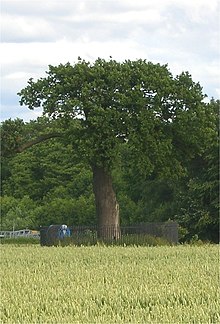Royal Oak (tree)

Royal Oak is the name of the oak tree in whose treetop Charles II hid himself in 1651 after the Battle of Worcester when he was fleeing from the Round Heads .
The tree was in Boscobel Wood, which was part of Boscobel House . In 1680 Karl confessed to Samuel Pepys that a soldier of the parliamentarians had passed right under him. After the Stuart Restoration , the anecdote was popular; the potter Thomas Toft of Staffordshire made many dishes , which with that of "The Lion and the Unicorn" was painted supported oak, peeking out the king's face from their branches.
Historical context
After the defeat of Charles' royalist army by Cromwell's New Model Army , the king fled with Lord Derby , Lord Wilmot and other royalists. They took refuge in the White Ladies Priory and in Boscobel House .
The king was among those hiding in Boscobel House. The owners of the estate, Charles Giffard and the Pendrell family, masked Charles II as a forester. A first attempt by the king to flee to Wales was thwarted by troops of the Commonwealth of England . He then met William Carlis (or Careless), one of the last royalists to escape the battlefield. According to tradition, after the restoration of the throne, it was Karl himself who changed Carli's name to Carlos , the Spanish form of the name Karl . The military rank of Carlis is not clear, the sources indicate a captain, major or colonel.
When Cromwell's troops approached the house in search of royalists, the King, Carlis, and William Pendrell hid in the Crown of the Oak for the day and hid in a loophole in Boscobel House the next day. Then Giffard and the Pendrells managed to use their contacts with other Catholics and smuggle the king with Lord Wilmot to France.
When King Charles II returned to the Kingdom of England in 1660 and ascended the throne again, he granted the Pendrells an annual pension in recognition of their services, which is still paid to the descendants of the family today. In addition, the Pendrells and Colonel Carlis were given the right to add an oak and three crowns to their coats of arms .
The oak today
The tree growing on the site today is not the original Royal Oak, which was destroyed during the 17th and 18th centuries when passers-by cut off twigs and pieces of bark as souvenirs. It is a two or three hundred year old offshoot of the original tree, which is why it is known as the "Son of Royal Oak" .
This "son of the royal oak" was badly damaged by a storm in 2000, during which it lost many branches. A new seedling was planted by Prince Charles near his site in 2001 . This was drawn from an acorn of the " Son of Royal Oak " and is therefore a "grandson" of the Royal Oak.
To commemorate the importance of the tree in British history, a number of places and objects have been named Royal Oak , including eight Royal Navy ships . The Royal Oak is the third most common name for a pub in the UK .
See also
Web links
- First Foot Guards: The Royal Oak
- The Leaking Wreck of HMS Royal Oak . Archived from the original on December 1, 2010. Retrieved October 18, 2013.
Individual evidence
- ↑ One of them is in the Metropolitan Museum ( illustration ).
- ↑ Strange Names
Coordinates: 52 ° 40 ′ 12 " N , 2 ° 14 ′ 30.4" W.
